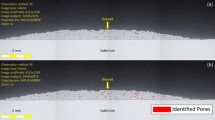Abstract
In the present era, polystyrene foam is widely used in foundries for pattern making. Industries extensively use the steam molding routes for polystyrene foam pattern making. However, the molding method cannot produce complex geometries. Industries are using the machining route for pattern making to overcome these limitations. There is limited research carried out on expanded polystyrene foam machining. Patterns need smooth surfaces with minimum surface roughness to make good quality castings. Therefore, there is a need to predict the surface roughness and its affecting parameters for polystyrene foam machining. The present article discusses a new theory for foam machining. The preliminary experiments identified two cutting mechanisms, mechanism I (through bead cutting) and mechanism II (bead removal). A novel mathematical model for the surface roughness has been developed and experimentally validated. A close correlation between the predicted and experimental values of average surface roughness (Ra) is observed with an average error of 19.70%. The correlation analysis shows a 93.07% correlation between the predicted and experimental values. The proposed mathematical model has been segregated into two parts because of through bead cutting and bead removal. Observation shows, the model part due to bead removal contributes significantly more (approximately 90% for all experiments) to the surface roughness. Therefore, surface roughness can be improved by minimizing or avoiding bead removal.










Similar content being viewed by others
Abbreviations
- R a :
-
Average surface roughness
- A d :
-
Bead dislocation/removal area
- A b :
-
Distorted bead area
- d :
-
EPS foam bead diameter(mm)
- a :
-
Cord diameter of foam bead in cutting plane
- x :
-
Position of mean line with respect to the cutting line
- Ө :
-
Deflection of the foam bead before cutting
- f :
-
Effective feed(mm/teeth)
- F :
-
Linear feed(mm/min)
- N :
-
Spindle speed(rpm)
- Z :
-
Number of teeth
References
Li S, Wang X, Xie L, Pang S (2015) The milling – milling machining method and its realization. Int J Adv Manuf Technol 76:1151–1161. https://doi.org/10.1007/s00170-014-6345-y
Santos MC, Machado AR, Sales WF (2016) Machining of aluminum alloys : a review. Int J Adv Manuf Technol 86:3067–3080. https://doi.org/10.1007/s00170-016-8431-9
Saptaji K, Gebremariam MA, Azhari MABM (2018) Machining of biocompatible materials : a review. Int J Adv Manuf Technol 97:2255–2292. https://doi.org/10.1007/s00170-018-1973-2
Benardos P, Vosniakos GC (2003) Predicting surface roughness in machining : a review. Int J Mach Tools Manuf 48:833–844. https://doi.org/10.1016/S0890-6955(03)00059-2
Petkov KP, Hattel JH (2017) Hot-blade cutting of EPS foam for double-curved surfaces—numerical simulation and experiments. Int J Adv Manuf Technol 93:4253–4264. https://doi.org/10.1007/s00170-017-0807-y
Luo H, Liu X, Wang Po (2021) Study on mechanical properties of lost foam pattern in machining. Key Eng Mater. https://doi.org/10.4028/www.scientific.net/KEM.904.148
Dongxia Y, Zhongde S, Feng L, Zhiquan Z (2014) The impact of the cutting process on the dimensional accuracy of expendable patterns. AMR 971–973:291–294. https://doi.org/10.4028/www.scientific.net/AMR.971-973.291
Chen H, Shan Z, Dong H (2013) Research of foam pattern processing for lost foam casting. AMM 331:600–603. https://doi.org/10.4028/www.scientific.net/AMM.331.600
Karunakaran KP, Agrawal S, Vengurlekar PD, Sahasrabudhe OS, Pushpa V, Ely RH (2005) Segmented object manufacturing. IIE Trans 37:291–302. https://doi.org/10.1080/07408170590516999
Paquet E, Bernard A (2021) Foam additive manufacturing technology: main characteristics and experiments for hull mold manufacturing. Rapid Prototyp J 27(8):1489–1500. https://doi.org/10.1108/RPJ-06-2020-0137
Aitchison DR, Brooks HL, Bain JD, Pons D (2011) Rapid manufacturing facilitation through optimal machining prediction of polystyrene foam. Virtual Phys Prototyp 6:41–46. https://doi.org/10.1080/17452759.2010.533961
Gote G, Kamble P, Kori S, Karunakaran KP (2020) Process optimization of segmented object manufacturing for expendable polystyrene foam. In: Praveen Kumar A, Dirgantara T, Krishna PV (eds) Advances in lightweight materials and structures. Springer Proceed Mater 8:695–704. https://doi.org/10.1007/978-981-15-7827-4_71
Sandhu K, Singh G, Singh S, Kumar R (2020) Surface characteristics of machined polystyrene with 3D printed thermoplastic tool. Materials 13:1–16. https://doi.org/10.3390/ma13122729
Malak SF, Anderson AI (2005) Orthogonal cutting of polyurethane foam. Int J Mech Sci 47:867–883. https://doi.org/10.1016/j.ijmecsci.2005.02.002
Brown CA, Brown CA (2011) Issues in modeling machined surface textures. Mach Sci Technol 4–3:539–546. https://doi.org/10.1080/10940340008945721
Ahmann KF, Kapoor SG, Devor RE, Lazoglu I (1997) Machining process modeling. J Manuf Sci Eng 119(4B):655–663. https://doi.org/10.1115/1.2836805
Vaitkus S, Laukaitis A, Gnipas I, Keršulis V, Vėjelis S (2006) Experimental analysis of structure and deformation mechanisms of expanded polystyrene (EPS) slabs. Mater Sci 12:323–327. ISSN 1392–1320
Rossacci J, Shivkumar S (2003) Bead fusion in polystyrene foams. J Mater Sci 38:201–206. https://doi.org/10.1023/A:1021180608531
Wang R, Wang B, Barber GC, Jie Gu, David Schall J (2019) Models for prediction of surface roughness in a face milling process using triangular inserts. Lubricants 7(1):2–14. https://doi.org/10.3390/lubricants7010009
Gadelmawla ES, Koura MM, Maksoud TMA, Elewa IM, Soliman HH (2002) Roughness parameters. J Mater Process Technol 123:133–145. https://doi.org/10.1016/S0924-0136(02)00060-2
Su H, Yang C, Gao S, Fu Y, Ding W (2019) A predictive model on surface roughness during internal traverse grinding of small holes. Int J Adv Manuf Technol 103:2069–2077. https://doi.org/10.1007/s00170-019-03643-z
Acknowledgements
The authors would like to acknowledge the support from the MHRD UAY 005 project. The authors would also like to thank the late Mr. Sunil Mohite, proprietor of JMT, Mumbai, for his guidance and Mr. Prashant Chaurasia, a research scholar at IIT Bombay, for his help.
Funding
Funding is provided by MHRD under UAY-005.
Author information
Authors and Affiliations
Contributions
Gopal Gote: conceptualization, validation, and writing original draft, Pushkar Kamble: validation, Rajendra Hodgir: validation, Yash Mittal: conceptualization, validation, K. P. Karunakaran: conceptualization and ideation.
Corresponding author
Ethics declarations
Ethics approval
Not applicable.
Consent to participate
Not applicable.
Consent for publication
All authors agrees to publish this manuscript in International Journal of Advance Manufacturing Technology and Confirms that this work has not been published anywhere before.
Conflict of interest
The authors declare no competing interests.
Additional information
Publisher's note
Springer Nature remains neutral with regard to jurisdictional claims in published maps and institutional affiliations.
Rights and permissions
About this article
Cite this article
Gote, G., Kamble, P., Hodgir, R. et al. Mathematical modeling of surface roughness in polystyrene foam machining. Int J Adv Manuf Technol 120, 7461–7475 (2022). https://doi.org/10.1007/s00170-022-09229-6
Received:
Accepted:
Published:
Issue Date:
DOI: https://doi.org/10.1007/s00170-022-09229-6




